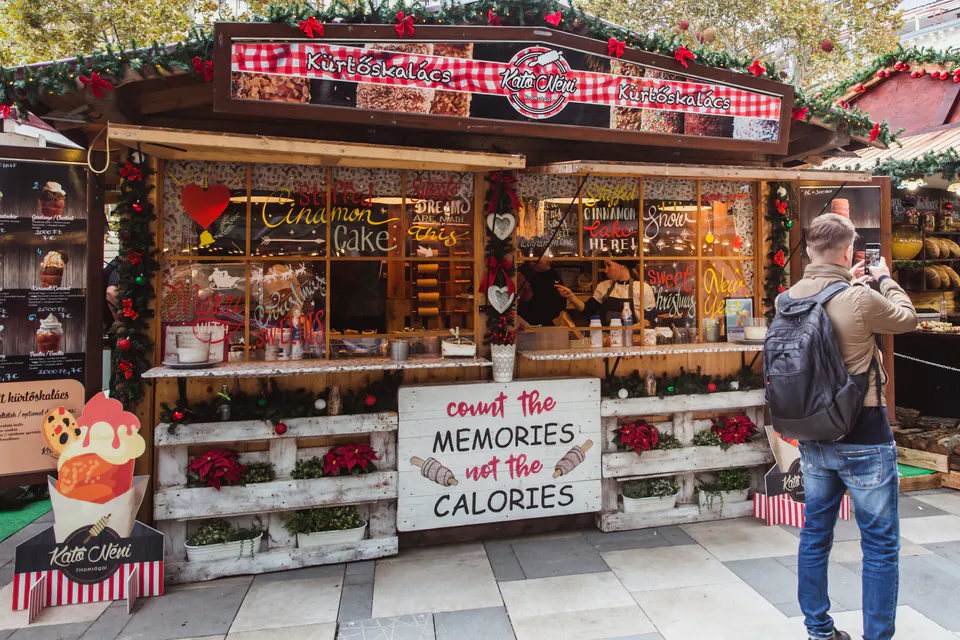Hungarian Desserts and Pastries in Budapest
Walking through Budapest's old streets, you can smell something amazing - caramelized sugar and fresh pastries coming from every direction. Hungarian desserts aren't just sweet treats. They tell stories about kings and queens, old traditions, and really talented bakers. Each bite gives you a taste of history that's as rich as the flavors. From fancy Dobos Torte that used to be served to royalty to simple chimney cakes that warm your hands at Christmas markets, Budapest's dessert scene takes you on an incredible journey through hundreds of years of amazing sweets.

Hungary's Most Famous Cakes
Dobos Torte: The King of All Cakes
This is Hungary's most famous cake, and you'll find it in every good pastry shop in Budapest. Dobos Torte is like a work of art - six to eight super thin sponge layers with chocolate buttercream between each one, topped with this shiny caramel layer that cracks when you cut into it. A guy named József C. Dobos invented it back in 1884, and get this - he made it so it wouldn't need a fridge, which was revolutionary back then.
What makes this cake so special is how it's built. The sponge layers use flour and potato starch to make them incredibly light. The chocolate buttercream has raw egg yolks in it (and sometimes cocoa butter), which makes it super rich. That hard caramel top gives you this amazing crunch, and the sides are covered with chopped nuts. We've tried this cake at tons of places, and when it's done right, each layer just melts in your mouth.
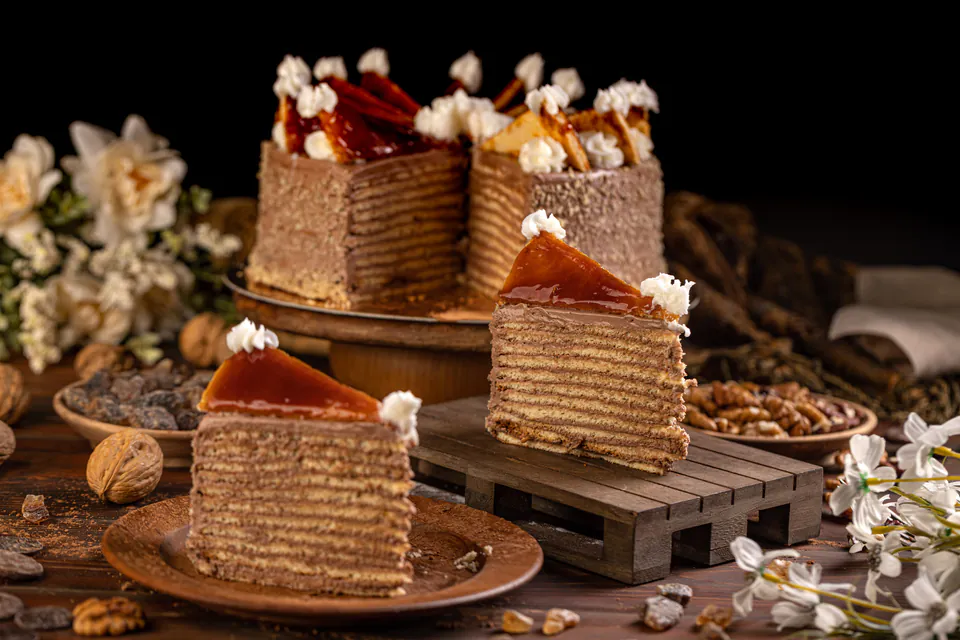
If you want the real deal, go to Café Gerbeaud on Vörösmarty Square. The place looks like something from a fairy tale, and their Dobos Torte is legendary. We also love Centrál Kávéház for the atmosphere. But if you want something more cozy, try Ruszwurm Confectionary near Fisherman's Bastion - it's Hungary's oldest pastry shop from 1827, so they know what they're doing.
Somlói Galuska: The Messy Masterpiece
Back in the 1950s, some creative people at Gundel Restaurant came up with what would become Hungary's favorite trifle. A waiter named Károly Gollerits and pastry chef József Béla Szőcs worked together to create Somlói Galuska, and it even won an award at the 1958 Brussels World Fair. Unlike neat English trifles, this dessert is meant to look like a beautiful mess with three different sponge cakes - plain, chocolate, and walnut.
Here's how they put it together. Each cake type tastes different and has its own texture. Then they soak everything with rum syrup, add vanilla custard, rum-soaked raisins, and chopped walnuts. The whole thing gets covered in whipped cream and usually gets some chocolate sauce drizzled on top. We discovered this dessert during our first trip to Budapest, and honestly, we weren't prepared for how good it would be.
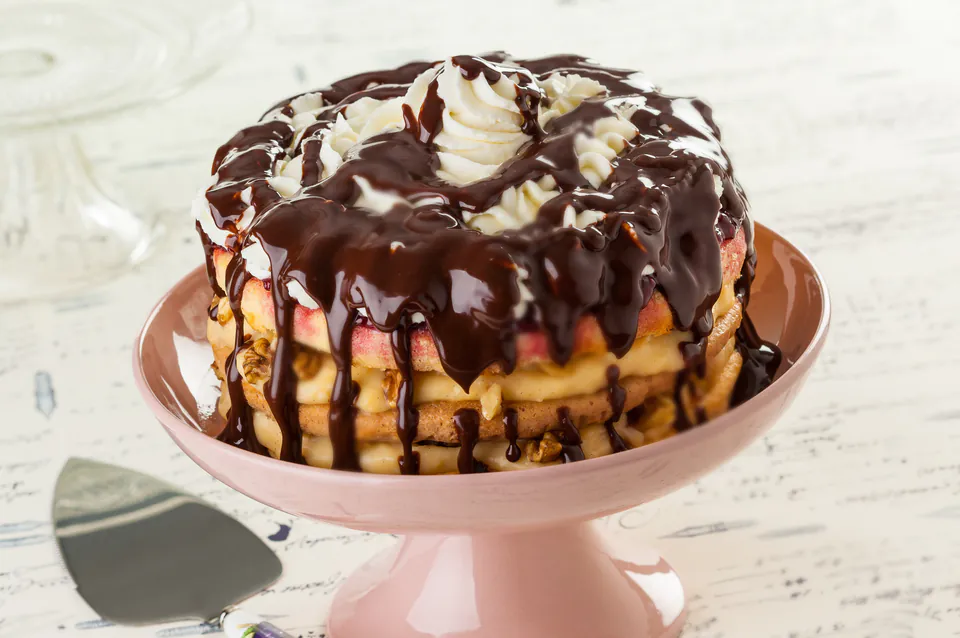
You have to try this at Gundel Restaurant where they invented it. The place is in City Park, and eating the original recipe where it was created is pretty amazing.
Eszterházy Torta: Fancy and Delicate
This cake is named after some prince (Prince Pál Antal Esterházy), and you can tell it was made for fancy people. It has four to six layers of almond or walnut meringue with vanilla buttercream that often has cognac in it. The whole thing gets covered with white fondant that has chocolate stripes in a spider web pattern. Each slice looks like a piece of art.
The meringue layers don't have any flour - just ground nuts and egg whites. This makes them crispy but soft at the same time. The buttercream is super smooth and rich, and sometimes they add orange liqueur or amaretto to make it even more interesting. We always recommend trying this if you want something elegant but not too heavy.
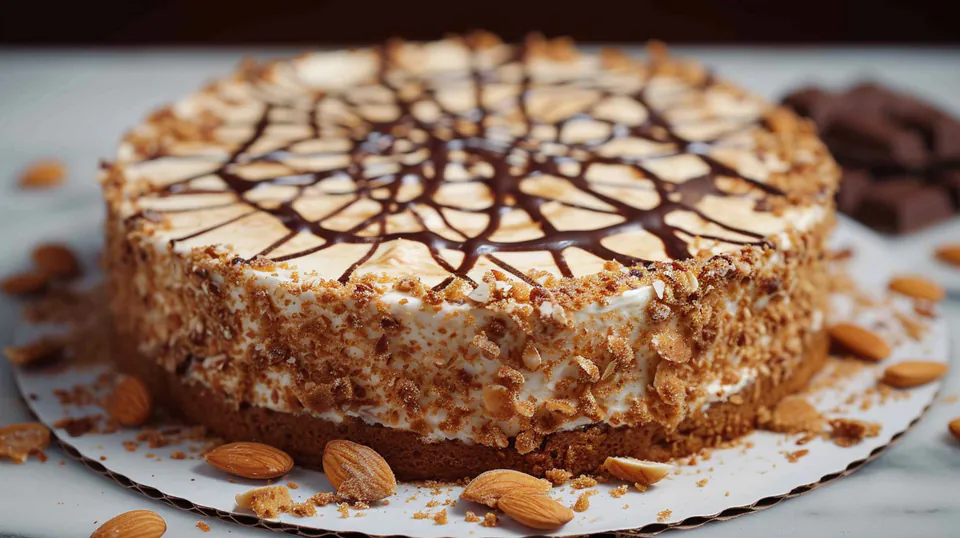
Málna The Pastry Shop in Óbuda won Best Pastry Shop in Hungary in 2022, partly because of their modern take on this classic. Auguszt Cukrászda has been around since 1870 and does the traditional version really well. Szamos is easier to find and their walnut version is pretty good too.
Street Food and Comfort Desserts
Kürtőskalács: The Sweet Street Smell
You'll smell these before you see them. The sugar caramelizing gives off this amazing smell that draws you in from blocks away. Kürtőskalács came from Transylvania but now you can find vendors all over Budapest. Watching them make these is half the fun - they wrap sweet dough around cone-shaped spits, roll it in sugar, then spin it over hot charcoal until the outside gets golden and crunchy.
The best part is the contrast. The outside is crispy and caramelized, but when you break it open, steam comes out like a chimney (that's why they call them chimney cakes). Traditional toppings are cinnamon, chopped walnuts, or coconut. Some vendors now stuff them with ice cream or dip them in chocolate, but we think the simple sugar-coated version is perfect.

Look for street vendors around Váci Street and at the Christmas markets. The Christmas markets are the best place to try these because eating something warm while walking around in the cold is just perfect.
Palacsinta: Hungarian Crepes Done Right
Hungarian palacsinta are way better than regular crepes. They make them super thin using batter with carbonated water, which makes them light and easy to roll without breaking. The batter has lots of milk and eggs but usually no butter, so they come out really delicate.
You can get them with sweet or savory fillings. For sweet ones, they do everything from simple powdered sugar to túró cheese mixed with vanilla and lemon. Fruit jams work great too, especially apricot and plum. Modern places use Nutella or chocolate pudding, but the fancy version is Gundel Palacsinta.
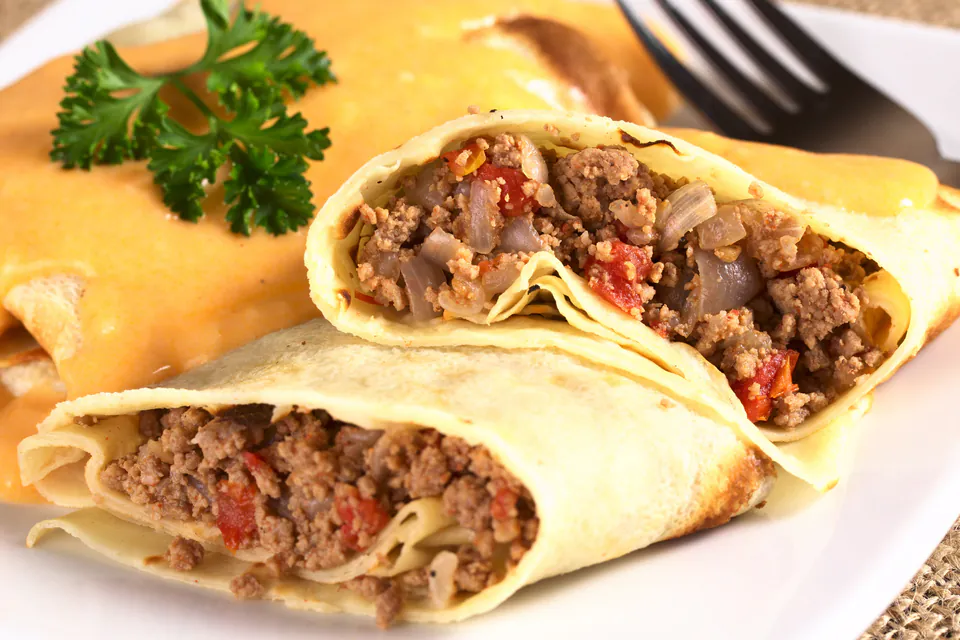
Gundel Palacsinta is this amazing creation from Gundel Restaurant that has ground walnuts, rum-soaked raisins, and candied orange peel, all covered with dark chocolate sauce. We always go to Gundel when we want the real thing, but there are lots of palacsinta restaurants around Budapest that do creative versions.
Túrógombóc: Simple but Amazing
Sometimes the simplest things are the best. Túrógombóc proves this - it's just túró cheese, semolina, and eggs made into little dumplings. The túró cheese is like farmer cheese or quark, and it has this nice tangy flavor that works perfectly with the traditional toppings.
After they cook the dumplings until they float, they roll them in toasted breadcrumbs that add this nutty taste and crunch. Then they serve them with sugar and sour cream (sometimes thinned with milk). Some recipes add vanilla or lemon to the cheese, and you might get jam on the side too.
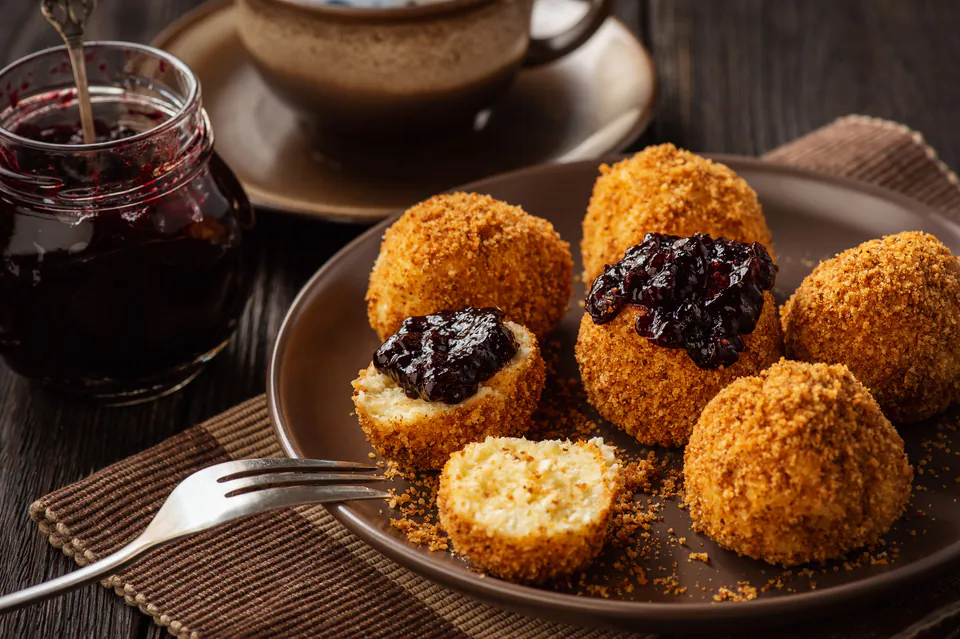
Gettó Gulyás in the Jewish Quarter makes incredible túrógombóc with pink cinnamon-flavored sour cream. We'd never seen that before, and it tastes as good as it looks. It shows how you can make traditional recipes more interesting without changing what makes them special.
Holiday Treats and Seasonal Sweets
Bejgli: Christmas Tradition
You can't have a Hungarian Christmas without bejgli. This traditional rolled pastry takes forever to make, but it's worth it. They start with rich yeast dough that gets rolled paper-thin, then spread with tons of ground poppy seeds or walnuts. The filling usually has raisins, almonds, and citrus peel, which creates these complex flavors that get better as it sits.
Rolling this thing requires serious skill. The dough has to be thin enough to create multiple spirals without tearing, and the filling needs to be just the right consistency. When it's done, you get this crackled crust and dense, sweet inside that actually improves over time. That's why people give them as gifts during the holidays.
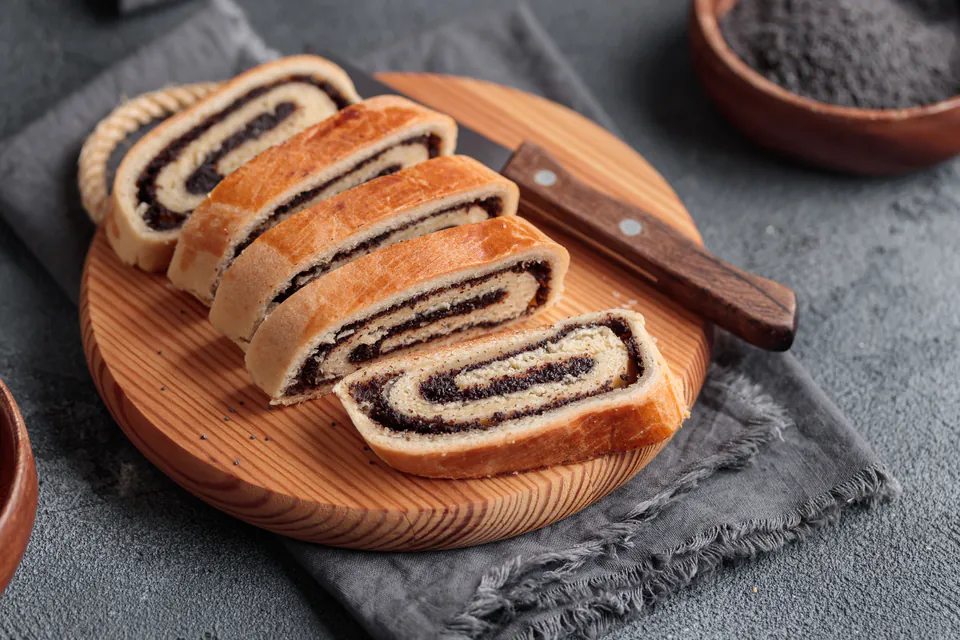
Gerbeaud makes classic versions during Christmas season. Auguszt Cukrászda has them year-round if you're craving this holiday treat in July. There's this big debate between poppy seed and walnut versions - most Hungarians prefer poppy seed because of its unique earthy flavor.
Mákos Guba: Winter Comfort Food
This humble dessert turns old bread into something really comforting. Mákos Guba combines being practical (using up stale bread) with being indulgent. They soak dry rolls in milk, then mix them with ground poppy seeds and sugar. It's like warm bread pudding with this distinctive nutty flavor that only poppy seeds can give.
Making it right is all about texture. The bread needs to absorb enough milk to get tender without becoming mushy. The poppy seeds have to be ground properly to release their oils and develop full flavor. Usually it comes with vanilla sauce or custard, which adds richness and goes perfectly with those earthy poppy seed notes.
This dessert means more than just food. Poppy seeds represent prosperity and good luck in Hungarian culture, so eating Mákos Guba at New Year is supposed to bring good fortune. We found out it's been around since 1695 when it appeared in the first printed Hungarian cookbook.
How Hungarian Pastry Making Works
Old Techniques and New Ideas
Making Hungarian pastries requires patience, precision, and respect for how things have always been done. The thin layers in Dobos Torte need perfect timing and temperature control. The meringue in Eszterházy Torta is super sensitive to humidity and technique. These skills get passed down from one generation of bakers to the next, and that's what makes Budapest's dessert scene so incredible.
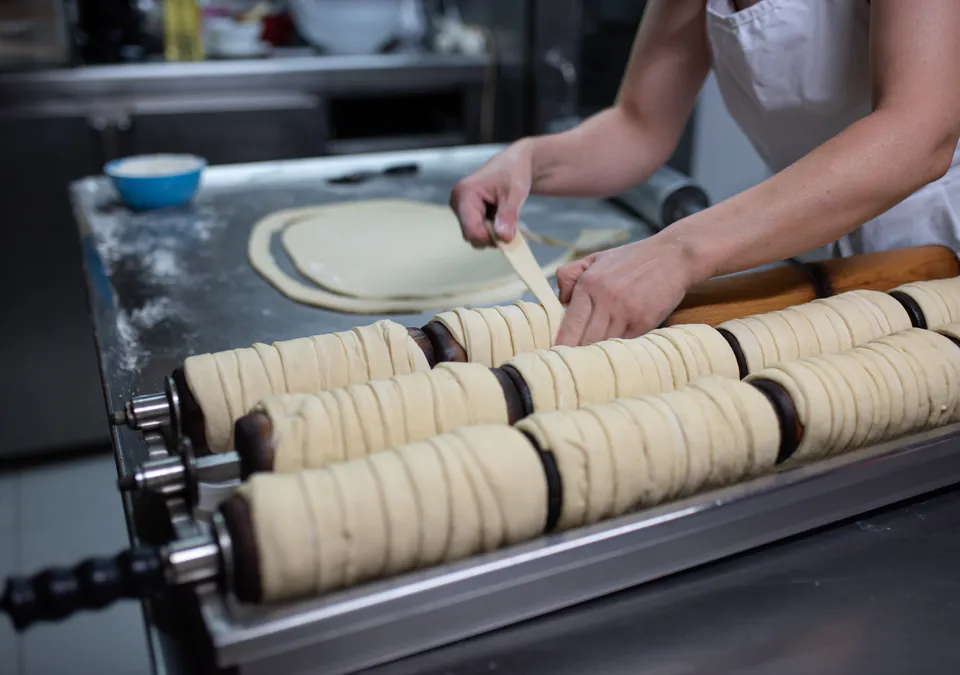
Modern Budapest pastry shops try to balance new ideas with tradition. The basic recipes stay mostly the same, but they experiment with how they present things and add new flavors to keep these classics interesting for younger people. Some places try gluten-free versions or use less sugar, though traditionalists argue that changes like that mess with what makes these desserts special.
Seasonal Ingredients and Different Styles
Hungarian desserts reflect what grows in the country and what's available during different seasons. Walnuts, hazelnuts, and almonds show up a lot because the region produces tons of nuts. Apricot and plum jams are everywhere because they preserve summer fruit to use all year. Poppy seeds, with their unique flavor and cultural meaning, are essential in many traditional recipes.
Even within Budapest, different places do things slightly differently. Some use almonds instead of walnuts in Eszterházy Torta. Others experiment with different spirits in their buttercreams. These small differences reflect individual pastry chefs' preferences and family traditions, which adds personality to classic recipes.
Essential Hungarian Desserts Guide
| Dessert | Type | Key Ingredients | Best Venues | Best Season |
|---|---|---|---|---|
| Dobos Torte | Layered Cake | Sponge layers, chocolate buttercream, caramel | Gerbeaud, Centrál Kávéház, Ruszwurm | Year-round |
| Somlói Galuska | Trifle | Three sponge cakes, rum, custard, walnuts | Gundel Restaurant | Year-round |
| Eszterházy Torta | Meringue Cake | Almond meringue, buttercream, fondant | Málna, Auguszt, Szamos | Year-round |
| Kürtőskalács | Street Pastry | Yeast dough, sugar, cinnamon | Street vendors, Christmas markets | Year-round, best in winter |
| Bejgli | Rolled Pastry | Yeast dough, poppy seeds or walnuts | Gerbeaud, Auguszt, local bakeries | Christmas season |
| Túrógombóc | Dumplings | Túró cheese, breadcrumbs, sour cream | Gettó Gulyás, traditional restaurants | Year-round |
Where to Find Budapest's Best Sweets
Historic Places and Modern Experts
Budapest's dessert scene goes from places that have been around for over a century to innovative modern pastry shops. Café Gerbeaud opened in 1858 and represents the top of traditional elegance. The fancy interior and prime location on Vörösmarty Square make it worth visiting just to see, and the dessert quality lives up to the reputation.
Centrál Kávéház gives you another taste of imperial grandeur. The Art Nouveau interior is the perfect setting for classic Hungarian cakes. Eating traditional desserts in their historical context really enhances the whole experience.
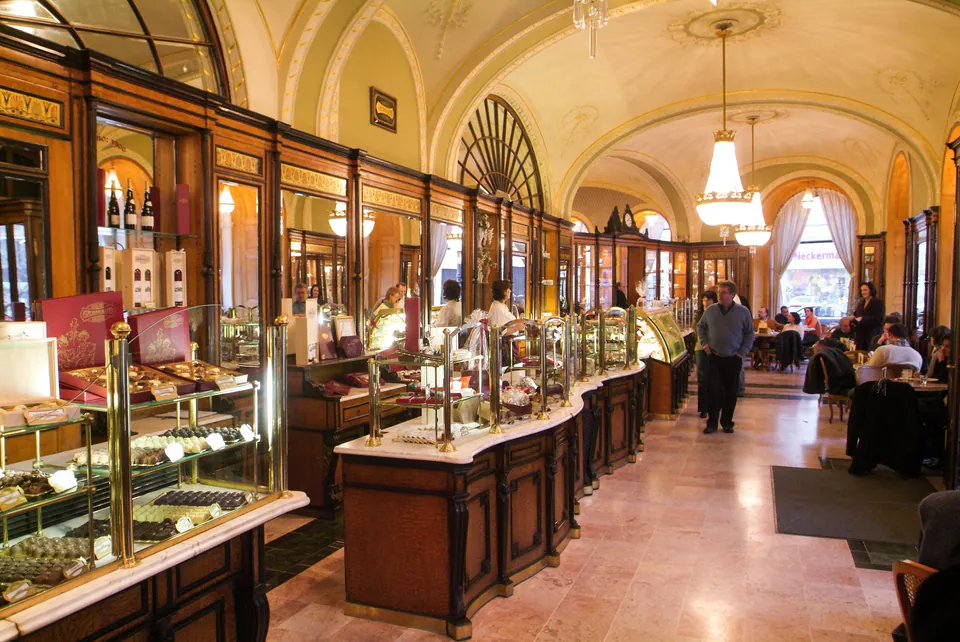
Smaller family places like Auguszt Cukrászda and Ruszwurm Confectionary give you more intimate experiences while keeping the quality really high. These places often let you watch traditional preparation methods, and the staff can explain the historical significance of different desserts.
Seasonal Markets and Street Food Scene
Budapest's seasonal markets, especially the Christmas markets, give you unique chances to try Hungarian desserts in festive settings. The smell of kürtőskalács mixes with mulled wine and roasted chestnuts, creating this amazing atmosphere for sampling traditional sweets. These markets often have vendors who specialize in just one thing, so they really know what they're doing.
Street food culture goes beyond just markets. Kürtőskalács vendors work year-round in tourist areas. The best ones use traditional charcoal heating and keep their toppings simple, focusing on perfecting the basic recipe instead of adding tons of modern stuff.
